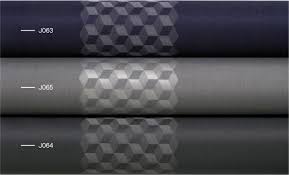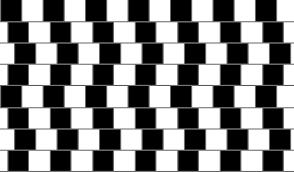Illusions Vertical Blinds

Colour plays an important role in solar protection. Colour choice directly affects heat and light penetration. Pale colours let through more heat but offer incomparable light. Dark colours keep things cooler but blocks out more of the sunshine. Colours also offer optimum UV protection. Dark shades provide total UVA and UVB protection, whereas paler shades provide protection similar to that of an SPF 50 skin cream. Motion, lights, and optical illusions open multiple perspectives for outdoor decorating and design. With this new jacquard dubbed 'Cube', the Opera range gives awnings a cinematic dimension, artfully combining special effects and metallic variations. A technical feat beyond compare, the Cube fabric is the result of an exceptional weave that plays with symmetries and dares to introduce 3D illusions. Metallic grey, mother-of-pearl white, warn denim... the silver screen version of awning fabric teams up brilliantly with any of the Orchestra solids for a box office hit every time.

Oversized patterns and broad bands of colour characterise the 14 references in the Opera range. In addition to the exciting Cube option, Opera boats 3 additional jacquards with remarkable personalities reminiscent of poppy seeds, pebbles and soho... that let nature play a starring role.
Change Reverse Light Bulb Bmw E60 Mandarin orange, raspberry pink, blueberry purple and apple green... the Pavot jacquard indulges the sassiest sweet tooth with a mixture of 4 fabulously flashy colours that feel like soft, cosy cotton.
Winter Tires Montreal Law 2011 A new shade of stone grey and simplified graphics combine smooth and metallic effects to make the Galet jacquard fit naturally and beautifully into its environment.
Homes For Sale In Scottsburg Va
The Soho jacquard lets lines run totally out of control for a fun-filled design. Sun-kissed with colours from Provence, these awning fabrics invite the lazy days of summer to take over your terrace. The constant quest for new materials and high-tech performance have earned Dickson® fabrics quite a reputation and their manufacturing process is what makes all the difference in the world. Dickson® fabrics are exclusively woven with Sunacryl solution-dyed acrylic fibres Developed by the Dickson® R&D teams, these exceptional quality fibres are solution- dyed, which means the colour pigments are incorporated during the actual manufacturing process, not afterwards, like most others. That’s why the colours stay true despite the sun, moon and weather.BrainBashers currently has 181 optical illusions. Optical illusions are often described as visual images that differ from reality - the eyes and brain 'see' something that doesn't quite match the physical measurement of the image.

Optical illusions can work in various ways, they can be images that are different from the objects that make them, they can be ones that come from the effects on the eyes and brain through excessive stimulation, and others where the eye and brain make unconscious inferences.Humans can see into the future, says a cognitive scientist. It's nothing like the alleged predictive powers of Nostradamus, but we do get a glimpse of events one-tenth of a second before they occur. And the mechanism behind that can also explain why we are tricked by optical illusions. Researcher Mark Changizi of Rensselaer Polytechnic Institute in New York says it starts with a neural lag that most everyone experiences while awake. When light hits your retina, about one-tenth of a second goes by before the brain translates the signal into a visual perception of the world. Scientists already knew about the lag, yet they have debated over exactly how we compensate, with one school of thought proposing our motor system somehow modifies our movements to offset the delay.

Changizi now says it's our visual system that has evolved to compensate for neural delays, generating images of what will occur one-tenth of a second into the future. That foresight keeps our view of the world in the present. It gives you enough heads up to catch a fly ball (instead of getting socked in the face) and maneuver smoothly through a crowd. His research on this topic is detailed in the May/June issue of the journal Cognitive Science, That same seer ability can explain a range of optical illusions, Changizi found. "Illusions occur when our brains attempt to perceive the future, and those perceptions don't match reality," Changizi said. Here's how the foresight theory could explain the most common visual illusions — geometric illusions that involve shapes: Something called the Hering illusion, for instance, looks like bike spokes around a central point, with vertical lines on either side of this central, so-called vanishing point. The illusion tricks us into thinking we are moving forward, and thus, switches on our future-seeing abilities.

Since we aren't actually moving and the figure is static, we misperceive the straight lines as curved ones. "Evolution has seen to it that geometric drawings like this elicit in us premonitions of the near future,” Changizi said. "The converging lines toward a vanishing point (the spokes) are cues that trick our brains into thinking we are moving forward — as we would in the real world, where the door frame (a pair of vertical lines) seems to bow out as we move through it — and we try to perceive what that world will look like in the next instant." In real life, when you are moving forward, it's not just the shape of objects that changes, he explained. Other variables, such as the angular size (how much of your visual field the object takes up), speed and contrast between the object and background, will also change. For instance, if two objects are about the same distance in front of you, and you move toward one of the objects, that object will speed up more in the next moment, appear larger, have lower contrast (because something that is moving faster gets more blurred), and literally get nearer to you compared with the other object.